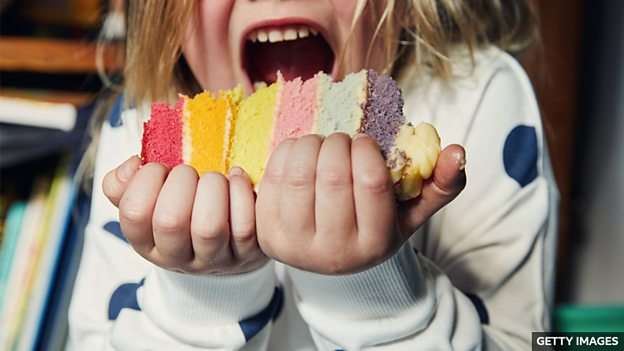食用色素可以提升食品的视觉吸引力,在食品工业中被广泛使用,因而其安全性一直备受关注。合成色素,如 “诱惑红” 和 “日落黄”,已经被证实与儿童的行为问题存在关联;还有一些色素可能会对人体健康构成潜在的威胁。本文浅谈食用色素的安全隐患以及可以替代它们的天然食物。
词汇:additives 添加剂
1 Food colouring is difficult to avoid. From bright orange cheesy crisps to frosted cakes, and even peanuts and meat, these additives make food more visually appealing. But for years, people have been worried about their safety and the long-term effects on our bodies. So, just how bad is food colouring, and what are the alternatives?
2 Synthetic food dyes, like Red 40 and Yellow 6, have been linked to hyperactivity and attention problems in children, particularly those in key stages of brain development. Studies show that even small amounts of these dyes, which are commonly found in ultra-processed foods, can affect behaviour. In 2010, the EU began requiring warning labels on products containing specific artificial colourings associated with hyperactivity in children.
3 There are further issues too, such as allergic reactions. Yellow 5 has been shown to produce hives, itching and symptoms typically associated with asthma in some people. It's derived from petroleum and is found in a range of foods, medicine and cosmetics. Red 3 is also problematic – links have been found between the colour and cancer in male rats. This dye is almost completely banned in the UK now, and food manufacturers in the USA have been given until 2027 to modify foods that currently use it in their recipe.
4 So, what can artificial colours be replaced with? There are natural alternatives like beetroot, turmeric, paprika and spirulina. Companies such as Fermentalg based in France are developing natural colourings from microalgae, such as Galdieria sulphuraria, which produces a bright blue pigment. Products using this colour are expected to be on shop shelves in the USA soon, alongside other natural blue dyes like butterfly pea extract and gardenia blue, which have all recently been approved by the Food and Drug Administration in the US. However, replacing synthetic dyes can be challenging because of stability, cost, and colour intensity. Natural dyes tend to be less vivid and have shorter shelf lives.
5 So, it's hard to avoid, but for your health do what you can to minimise unnecessary artificial colours in what you eat, and stick to natural alternatives instead.
测验与练习
一、为本文选择总结句。
1. Which statement best summarises the article?
a. All food colouring is generally harmful.
b. Natural alternatives are replacing artificial food dyes.
c. Dyes are essential for making food look appetising.
二、根据文章内容选出正确的选项。
1. The safety of food dyes has recently become a worry for people.
a. True
b. False
c. Not given
2. What products are warning labels required to be on in the EU?
a. Foods that are essential for children's brain development
b. Ultra-processed foods
c. Foods containing colours associated with hyperactivity in children
3. The dye Red 3…
a. can produce allergic reactions, including hives.
b. is banned in the UK.
c. is being removed from food products in the USA.
4. What does 'this colour' refer to in the following sentence? Products using this colour are expected to be on shop shelves in the USA soon.
a. Microalgae
b. Galdieria sulphuraria
c. Butterfly pea extract
5. Why can replacing synthetic dyes with natural ones be a challenge?
a. Because natural dyes are more vivid in colour and don't last as long
b. Because synthetic dyes have more intense colours and longer shelf lives
c. Because the cost of synthetic dyes is higher than natural alternatives
三、用下列单词完成对本文的总结。
There are numerous 1) _______ dyes out there these days, such as 2) _______which gives food a yellow colour. A lot of 3) _______ colours have been given 4) ________ in the EU due to their associations with 5) _______ in children and occasionally allergic reactions.
natural
behaviour
hyperactivity
warning labels
turmeric
beetroot
artificial
(答案见词汇表后)
词汇表
frosted 撒了糖霜的
visually appealing 视觉上吸引人的
synthetic 合成的,人造的
hyperactivity 多动亢奋
ultra-processed 超加工的
warning label 警告标签
artificial 人造的
allergic reaction 过敏反应
hives 荨麻疹
asthma 气喘,哮喘
ban 禁止
beetroot 甜菜根
turmeric 姜黄根粉
paprika 红辣椒粉
spirulina (可食用的)干螺旋藻
microalgae 微藻
pigment 色素
extract 提取物
vivid 鲜艳的
shelf life 保质期
答案
一、为本文选择总结句。
b. Natural alternatives are replacing artificial food dyes. So, what can artificial colours be replaced with? There are natural alternatives like beetroot, turmeric, paprika and spirulina. Products using this colour are expected to be on shop shelves in the USA soon, alongside other natural blue dyes like butterfly pea extract and gardenia blue, which have all recently been approved by the Food and Drug Administration in the US.
二、根据文章内容选出正确的选项。
1. b. False. But for years, people have been worried about their safety and the long-term effects on our body.
2. c. In 2010, the EU began requiring warning labels on products containing specific artificial colourings associated with hyperactivity in children.
3. c. Another problematic colour is Red 3, … and food manufacturers in the USA have been given until 2027 to modify foods that currently use it in their recipe.
4. b. Companies … are developing natural colourings from microalgae, such as Galdieria sulphuraria …Products using this colour are expected to be on shop shelves in the USA soon
5. b. However, replacing synthetic dyes can be challenging because of stability, cost, and colour intensity. Natural dyes tend to be less vivid and have shorter shelf lives.
三、用下列单词完成对本文的总结。
There are numerous natural dyes out there these days, such as turmeric which gives food a yellow colour. A lot of artificial colours have been given warning labels in the EU due to their associations with hyperactivity in children and occasionally allergic reactions.

